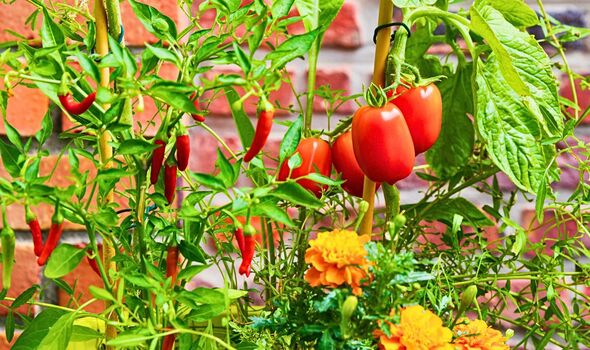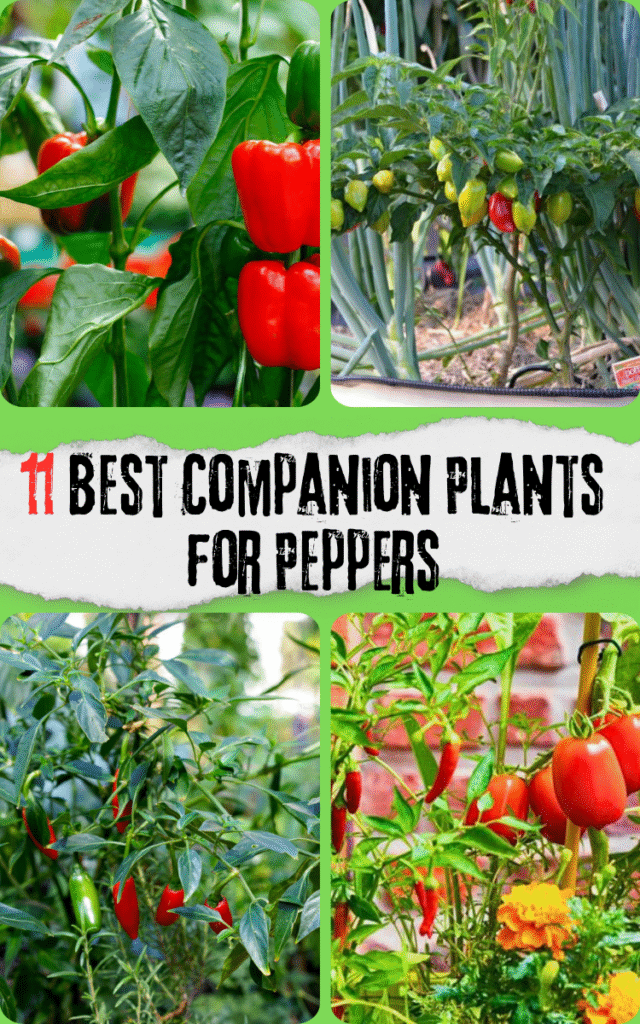
When I first started growing peppers, I thought success depended solely on sunlight, watering, and good soil. But after a few disappointing seasons, I realized there was more to it — and that’s when I discovered companion planting. This simple technique completely changed how my pepper plants performed. Suddenly, they looked healthier, produced more fruit, and had far fewer pest problems.
Companion planting is about creating relationships between plants that benefit each other. Peppers, in particular, thrive when paired with the right neighbors — plants that protect them from pests, improve the soil, and even enhance their flavor. On the flip side, planting them next to the wrong companions can lead to stunted growth or pest infestations that quickly get out of control.
In this guide, I’ll walk you through the 11 best companion plants for peppers, along with a few you’ll definitely want to avoid. These combinations have worked wonders in my garden and can help you create a healthier, more balanced ecosystem for your plants to thrive.
Why Companion Planting Works for Peppers
Companion planting works because plants, like people, don’t thrive in isolation. Each one contributes something different — from natural pest deterrence to improved pollination and nutrient balance. Peppers, in particular, benefit from nearby plants that help stabilize their growing environment, provide shade, or even enrich the soil naturally.
Peppers love warmth, sunlight, and nutrient-rich, well-drained soil. However, they can be vulnerable to pests like aphids, spider mites, and cutworms. By planting helpful companions nearby, you can minimize those threats while promoting healthier growth and bigger harvests. For instance, some plants repel pests with their scent, while others attract beneficial insects that keep the bad ones in check.
When planning your garden, think of companion planting as strategic teamwork. It’s not just about proximity — spacing, light exposure, and soil balance matter too. A well-arranged pepper bed can create a thriving ecosystem that practically takes care of itself.
The 11 Best Companion Plants for Peppers
1. Basil – The Pest-Fighting Powerhouse
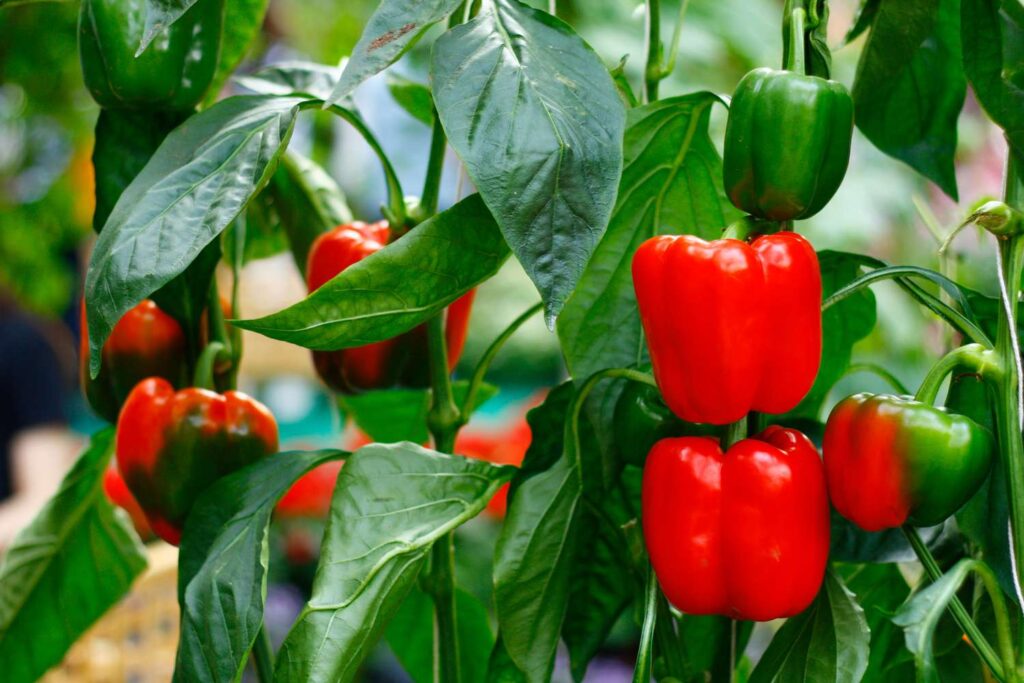
Basil and peppers are a match made in garden heaven. Basil’s strong aroma deters common pepper pests like aphids, spider mites, and mosquitoes. Plus, it enhances the flavor of nearby peppers — a subtle but real effect many gardeners swear by. I like planting basil between my pepper rows, letting its fragrance act as a natural pest barrier.
Beyond pest control, basil thrives in similar growing conditions. Both plants love warm weather, full sun, and well-drained soil. Their watering needs also align, making them easy companions to care for side by side.
Just give each basil plant enough space so it doesn’t overshadow young peppers. The combination not only keeps bugs away but also adds beauty to your garden with its lush green leaves and occasional tiny white flowers.
2. Marigolds – The Natural Pest Repellent
If there’s one flower every vegetable garden needs, it’s marigolds. These cheerful blooms aren’t just pretty — they’re powerful pest deterrents. Their scent drives away nematodes, aphids, and even whiteflies, all of which can harm pepper plants.
I like to plant marigolds as a border around my pepper beds. Their golden and orange flowers create a bright frame while providing natural protection. Plus, marigolds attract pollinators, which means more blooms and, eventually, more peppers.
They’re low-maintenance and bloom for months, making them a long-lasting addition to any garden. When paired with peppers, marigolds are like the bodyguards of your vegetable patch — colorful, reliable, and always on duty.
3. Onions – The Odor Shield
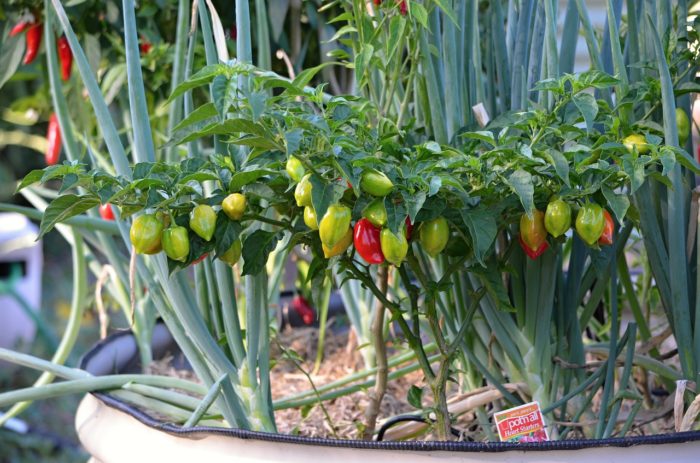
Onions are another fantastic companion for peppers because of their pungent smell. That aroma confuses pests like thrips and aphids, keeping them from finding your pepper plants in the first place. Their scent is a natural repellent that provides round-the-clock protection.
Since onions have shallow roots, they won’t compete with peppers for nutrients or space. I usually plant them in between pepper rows, and they seem to coexist peacefully. It’s an efficient use of garden space that pays off in both pest control and harvest variety.
One thing I’ve learned: rotate your onion crops each year. It keeps the soil from depleting and prevents disease buildup. That way, both your onions and peppers stay healthy season after season.
4. Carrots – The Space-Saving Companion
Carrots are small but mighty allies for peppers. Their roots help loosen compact soil, giving pepper roots more room to spread and access nutrients. This subtle improvement can make a noticeable difference in pepper growth and fruit yield.
Another bonus is that carrots grow underground and have small, fern-like tops that don’t compete for sunlight. That means they can easily share a garden bed with peppers without shading them out.
Because carrots need consistent moisture, it’s important to balance watering between the two crops. I like to mulch around them to retain moisture and keep weeds under control. It’s an easy partnership that makes the most of limited space.
5. Spinach – The Living Mulch
Spinach works wonderfully as a living mulch for pepper plants. Its broad leaves shade the soil, keeping it cool and moist — exactly what peppers need during hot spells. This ground cover also suppresses weeds, saving you time on maintenance.
The relationship goes both ways. Once peppers grow taller, they provide shade to spinach, extending its growing season before it bolts. This synergy creates a balanced microclimate that benefits both plants.
I usually plant spinach early in the season so it’s well-established before the peppers mature. It’s a simple technique that not only improves soil health but also keeps your garden looking lush and productive.
6. Tomatoes – The Family Companion
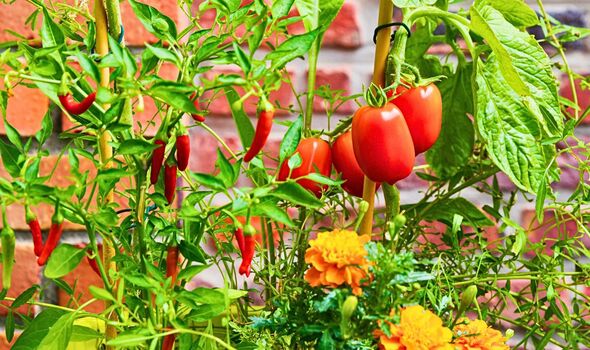
Peppers and tomatoes are both part of the nightshade family, which means they share similar growing needs. They both love warmth, sun, and well-drained soil — making them natural companions.
Tomatoes can help shade the soil around peppers, reducing evaporation and keeping the roots cool. However, it’s important not to plant them too close together, as they can compete for nutrients or share diseases like blight.
A little spacing and rotation between seasons make this partnership thrive. When done right, you’ll enjoy fuller plants and a harvest that’s both colorful and abundant.
7. Lettuce – The Quick Grower
Lettuce is one of my favorite filler crops around peppers. It grows fast, covers bare soil, and helps suppress weeds. Since it has shallow roots, it doesn’t compete with peppers for nutrients or water.
I like planting lettuce in early spring, allowing it to mature before the peppers fully develop. By the time the peppers need more space, the lettuce is usually ready to harvest. It’s an efficient way to use garden beds while maximizing your harvest.
The best part? Lettuce helps maintain moisture around pepper roots, acting as a living mulch early in the season. It’s the perfect example of a short-term companion that supports long-term growth.
8. Nasturtiums – The Trap Crop
Nasturtiums are as useful as they are beautiful. These vibrant flowers act as trap crops, luring aphids, whiteflies, and other pests away from pepper plants. I’ve noticed fewer infestations since adding nasturtiums near my pepper rows.
Their bright orange and red blooms attract pollinators, too — bees and butterflies that help improve overall garden health. As a bonus, nasturtiums are edible, adding a peppery flavor to salads.
They grow quickly, sprawl nicely, and need little attention once established. For both beauty and protection, nasturtiums are a must-have companion for peppers.
9. Oregano – The Aromatic Protector
Oregano’s strong aroma makes it an excellent pest deterrent. It repels insects naturally while also attracting beneficial ones like bees and hoverflies. Its low, bushy growth pattern provides ground cover that helps retain soil moisture.
Because oregano loves the same dry, sunny conditions as peppers, it’s an effortless match. I plant it along the edges of pepper beds so it can spread without crowding the main plants.
This combination not only keeps pests at bay but also adds a lovely Mediterranean scent to your garden. Plus, you’ll always have fresh oregano ready for the kitchen.
10. Cucumbers – The Moisture Partner
Cucumbers can be surprisingly good companions for peppers. Their broad leaves shade the soil and help it retain moisture, which peppers appreciate during hot months. When trained properly, cucumbers can spread as living ground cover beneath taller pepper plants.
Just be mindful of spacing. Cucumbers are vigorous growers, and if left unchecked, they can overwhelm nearby plants. I like to use trellises to keep cucumber vines vertical and the garden organized.
When balanced well, this duo thrives together — with cucumbers cooling the soil and peppers benefiting from the extra humidity.
11. Chives – The Micro Guardian
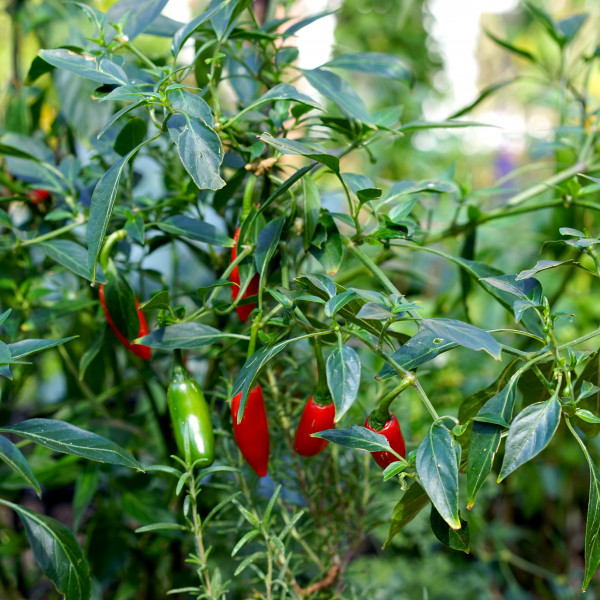
Chives might be small, but their benefits are big. Their mild onion scent deters aphids, beetles, and mites, which often target pepper plants. They also attract pollinators when in bloom, thanks to their pretty purple flowers.
Chives have a compact growth habit and shallow roots, so they won’t compete with peppers for space. I like to plant them in clusters around the edges of pepper beds for an attractive and functional border.
It’s a low-maintenance pairing that improves garden diversity while offering an edible bonus you can use in the kitchen year-round.
Plants to Avoid Near Peppers
1. Fennel
Fennel might look harmless, but it’s a poor neighbor for peppers. It releases natural chemicals into the soil that inhibit the growth of many plants, including your beloved peppers. This phenomenon, called allelopathy, can stunt development or even prevent peppers from germinating properly.
If you love fennel, plant it far away from your pepper bed. It does best on its own or near herbs like dill that can handle its strong influence.
It’s one of those plants that prefers independence — a good reminder that not every garden friendship works out.
2. Brassicas (Cabbage, Broccoli, Cauliflower)
Brassicas are heavy feeders that compete fiercely for nutrients. Their broad leaves also shade smaller plants like peppers, depriving them of sunlight. When planted nearby, they can limit pepper growth and reduce fruit yield.
These plants also attract pests like aphids and cabbage worms, which may migrate to your pepper plants. I once made the mistake of planting broccoli too close to my peppers — and let’s just say, the peppers didn’t stand a chance.
Keep brassicas in a separate section of your garden with plenty of space. They do better with crops like beets or onions instead.
3. Beans
Beans fix nitrogen in the soil, which sounds helpful — but for peppers, it’s too much of a good thing. Excess nitrogen can lead to lush, leafy growth at the expense of fruit production.
Additionally, beans often attract pests like beetles that also enjoy nibbling on pepper leaves. Pole beans can also overwhelm peppers with their vines, blocking light and space.
If you want to grow both, give them separate beds or keep them at opposite ends of the garden.
4. Corn
Corn and peppers might grow in similar climates, but they’re not compatible. Corn attracts cutworms and corn earworms, both of which can harm pepper plants. Its tall stalks also cast too much shade, making it hard for peppers to get the sunlight they need.
Corn is a heavy feeder too, so it competes with peppers for nitrogen and water. The result is often smaller, weaker pepper plants.
It’s best to separate these two crops entirely to prevent pest problems and uneven growth.
5. Potatoes
Potatoes and peppers share too many similarities — and that’s the problem. Both are nightshades, making them susceptible to the same diseases like blight and root rot. If one gets infected, it can easily spread to the other.
Potatoes also demand a lot of nutrients from the soil, leaving little for peppers to thrive on. Their dense foliage can also limit airflow around pepper plants, increasing disease risk.
Keeping them apart ensures both crops stay healthier and produce better yields.
How to Arrange Companion Plants in Your Pepper Garden
When arranging companion plants, think in layers and spacing. Taller plants like tomatoes or basil can act as a protective canopy, while shorter companions like lettuce or spinach fill the ground below. This creates a balanced ecosystem where every inch of soil serves a purpose.
For in-ground gardens, I like alternating rows of peppers and herbs, with flowers like marigolds or nasturtiums along the borders. It keeps pests at bay while adding color and variety.
If you’re growing in containers, pair one pepper plant with a smaller herb like chives or oregano. You’ll get the same companion benefits without overcrowding.
Common Mistakes to Avoid in Pepper Companion Planting
It’s easy to get excited and overplant, but crowding your garden can lead to poor airflow and disease. Peppers need space to breathe, so always follow recommended spacing.
Another common mistake is mismatched watering needs. Some companions, like cucumbers, need more water, while others, like oregano, prefer drier soil. Plan your layout so similar plants share the same irrigation zone.
Lastly, don’t forget about crop rotation. Planting peppers in the same spot year after year can deplete soil nutrients and increase disease risk. Rotate your crops annually for long-term garden health.
Create a Thriving Pepper Ecosystem
Gardening isn’t just about growing plants — it’s about growing relationships between them. When you choose the right companions for your peppers, you create a small ecosystem that practically sustains itself. Pests decrease, soil improves, and your harvest becomes more abundant.
Experiment with different combinations and watch how your peppers respond. Each garden has its own rhythm, and discovering what works best for yours is part of the fun.
With a little planning and the right companions, your pepper plants will flourish — vibrant, healthy, and full of flavor season after season.

